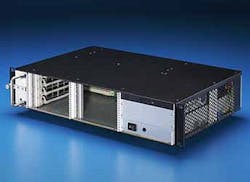2U rugged enclosure for military embedded systems introduced by Pixus Technologies
WATERLOO, Ontario, 2 Aug. 2012. Pixus Technologies in Waterloo, Ontario, is introducing the 2U VME64x enclosure in the SlimBox style with as many as four slots for military embedded systems. The rugged backplane comes with pluggable 47-pin PSU connectors in one 9U-long horizontal mount backplane.
The 2U VME64x SlimBox rugged enclosure for embedded computing features ESD and EMC protection. The chassis are 2U high by 19 inches wide by 300 millimeters depth and have optional rear I/O. Hot swappable AC or DC power supplies to 250 Watts are standard. Other power options are available.
The Pixus Technologies 9U monolithic VME64x backplanes come with active or passive termination and provisions for one or two 47-pin PSU connectors. A header is provided for system management options with SYSReset, SysFail, ACFail_PS, and Ground signals. The backplane also has provisions to work with the Pixus mini alarm cards.
Story continues below
Related stories
AdvancedTCA, CompactPCI, and VME-based embedded computing packaging offered by Pixus
Handles and panels for 3U, 6U, 9U, and custom embedded computing boards introduced by Pixus
3U VPX rugged enclosure for UAVs and other mission-critical airborne applications introduced by Dawn VME.
Pixus also offers VME64x chassis in 1U and 4U SlimBox versions, as well as vertical-mount enclosures in 4U, 7U, 8U, 9U, and larger heights. The company offers VME64x backplane slot sizes in 6U, 6.5U for increased power, and 9U monolithic versions. VME, CompactPCI, and OpenVPX backplanes are available.
For more information contact Pixus Technologies online at www.pixustechnologies.com.
Follow Military & Aerospace Electronics and Avionics Intelligence news updates on Twitter

